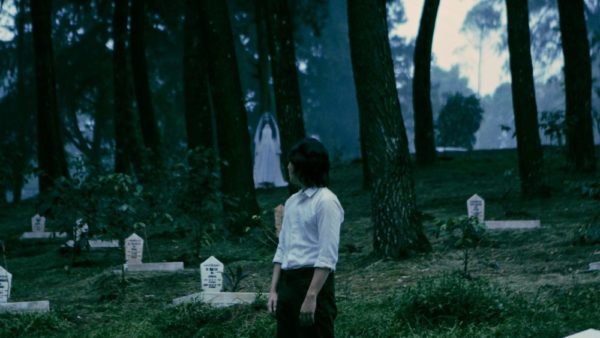
Coverage of Fantasia Festival 2018 continues with Indonesian sensation, Satan’s Slaves.
Let’s bitch it out…
In my preview for this year’s Fantasia Festival, I highlighted Satan’s Slaves as my “must watch” film. The buzz from the festival circuit has been excellent and reviews of the film have highlighted both its box office prowess and its accelerated expansion into the Asian film market.
The logline is as follows: family matriarch Mawarni Suwono (Ayu Laksmi) was once a famous singer, but she’s been felled by a mysterious illness for three years. Bedridden and barely conscious, Mawarni relies on her family for care, using a handheld bell to summon them to her bedside*. The family is understandably worn and financially impoverished, never moreso than when Mawarni dies. In the wake of her death, the father must travel to the city to take care of business, leaving 22-year-old daughter Rini (Tara Basro) responsible for 16-year-old Tony (Endy Arfian), 10-year-old Bondi (Nasar Annuz); and mute 6-year-old Ian (Muhammad Adhiyat). Mysterious events begin occurring, suggesting that Mawarni is still present in the house and haunting her children.
*Much has been made about the use of a chilling sound effect used to generate horror in this and Hereditary. While the comparison is justified, the films arguably use their respective oral tics differently.
I’ll concede that I am susceptible to hype (possibly more than other people), so perhaps I should have known better than to go into the film with outrageous expectations. Unfortunately the film left me a bit cold and in the days since I screened it, I’ve been trying to evaluate why:
Pros
- The direction: Indonesian filmmaker Joko Anwar is clearly a pro because the film’s direction is flawless. The camera framing is well-used to reinforce the constant threat of objects (or subjects) just out of sight, which goes a long way towards creating tension and anxiety.
- The aesthetic: The film is set in the early 80s and the period setting definitely evokes a mash-up of European and American horror aesthetics from the time. The look of the film, especially the lived-in house, is a character unto itself.
- The performances: The actors are uniformly good, particularly the children, who are invaluable to much of Satan’s Slaves horror.
- The road death: There’s one death as the film barrels towards its climax, when a character meets a most disagreeable ending on the highway and it is delightfully gory and disgusting. A+

Cons
- Rini: The film employs a certain amount of misdirection setting up Rini as its protagonist: initially it appears that she will be the one to solve the family mystery. To a certain extent this is true – she does uncover the truth behind the haunting with the help of the boy next door – but aside from this, Rini is disappointingly ineffectual in addressing the danger and she is frequently sidelined during the extended climax.
- The scares: Considering the hype and the reviews, it’s disappointing that the majority of Satan’s Slaves scares are the result of ghostly jump scares (something freaky appears behind or over the shoulder of a character looking the other way). The first few times this occurs, the jump scares work, even when they are obvious and expected. As the film goes on, however, these same scares yield diminishing returns. The fact that the film never expands its repertoire of scares is disappointing.
- The explanation: There’s no twist, per se, to the film (the title is a clear indication of where the film intends to go), but the thuddingly plain explanation for the ghostly events is delivered in such a bland and convenient exposition dump that the film risks becoming laughable.
- The climax: While I’ll concede that I’ve been groomed by US films that are edited as though the primary audience are children suffering from attention deficient disorder, the ending of Satan’s Slaves drags on far too long, with very little pay-off. The entire film naturally builds to a climax that pits the family against the forces of evil, using the isolated house as the battleground to drive home the film’s familial horror themes. Alas, it is far less of a battle and more a collection of vignettes in which various members of the house run around, locking doors, getting separated, venturing outdoors and then immediately returning inside, etc. By adopting the conventions of an old school zombie film, the ghosts/satanists are reduced to slow lumbering menaces; atmospheric, but hardly scary and barely threatening. Play this out for 20+ minutes and Satan’s Slaves overstays its welcome instead of going out on a high.
The Bottom Line: Good direction, performances and aesthetic can’t overcome a lack of scares, overly simplistic exposition and a protracted ending that weighs the film down. Satan’s Slaves is worth a watch, but don’t rush out to see it.